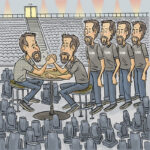A “mix” is more or less a concept of assigning layers and sampling regions of pixels in the raster that you want to be displayed in a specific location in the output. While servers may only have a fixed number of physical outputs, many more display image areas can be possible via the creative use of mixes. Let’s say your server has one video output, and the resolution of that output is 1920 x 1080. And let’s say we have two LED video screens, and the resolution of each LED screen is 960 x 1080. If you add a multi-head display device like a Dual-HeadToGo, you can create two mixes. Once each mix has been created, layers assigned and sample region determined, then the display devices (like an LED processor) connected to each of the outputs of the multihead display device have to be configured to display the same pixel region as each of the mixes. Then, when the mixes are output, it will only be displayed on the area of pixels that you designate within the LED processor. Just because there are a defined number of pixels in a single output does not mean all have to be a part of the same image at the same time.
-Vickie Claiborne, from “Video Digerati,” PLSN, Oct. 2017, page 102


